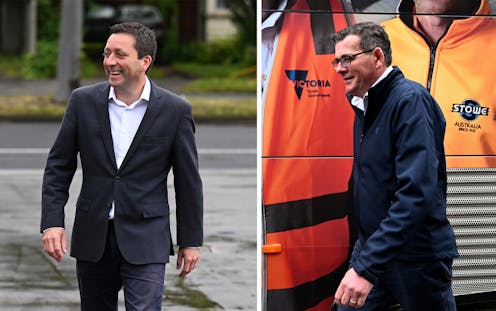Victorian Labor slumps in Resolve poll but still in winning position; Labor failure on upper house reform comes back to bite
- Written by Adrian Beaumont, Election Analyst (Psephologist) at The Conversation; and Honorary Associate, School of Mathematics and Statistics, The University of Melbourne

The Victorian state election is on Saturday with polls closing at 6pm AEDT. There are 88 single-member lower house seats with members elected by preferential voting, and 40 upper house seats in eight five-member electorates.
A Resolve poll[1] for The Age, conducted November 16-20 from a sample of about 1,000, gave Labor a 53-47 lead, a six-point gain for the Coalition since late October. Primary votes were 36% Labor (down two), 36% Coalition (up five), 10% Greens (down two), 6% independents (down six) and 12% others (up six).
I believe Resolve is now using actual ballot papers in all lower house seats (as this poll was conducted after nominations closed on November 11). As prominent independents are not running in every seat, the independent vote crashed while the “others” vote surged. The Greens may be losing votes to Animal Justice.
Read more: Two Victorian polls have large Labor leads 12 days before election; US Democrats hold Senate at midterms[2]
Labor Premier Daniel Andrews continued to lead the Liberals’ Matthew Guy as preferred premier by 48-34 (49-29 in October), but this was Guy’s highest rating in Resolve polls.
A 53-47 statewide two party win for Labor would still be a clear victory for them in the lower house, but there are two worries for Labor: the prospect of further narrowing in the final week, and the preferences of the 12% others. It’s plausible most of the others dislike Andrews.
Labor’s failure to reform upper house allows ‘preference whisperer’ to flourish
There has been recent media attention on the anti-democratic group voting ticket (GVT) system used to elect Victoria’s upper house after the leaking of the video below in which preference whisperer Glenn Druery brags about his influence.
Glenn Driuery.As I have said before, Victorian Labor has been in government for eight years, but made absolutely no attempt to reform the upper house system by axing GVT. Druery would have no influence if above the line voters were able to direct their own preferences.
After reforms made in the last seven years in other jurisdictions, Victoria is now the only Australian jurisdiction that still uses GVT for above the line votes. At the May federal election, Victorian votes for the Senate were allocated according to voter-directed above the line and below the line preferences.
Read more: How Victorian Labor's failure on upper house electoral reform undermines democracy[3]
At this election, the only way for voters to direct their own preferences is to number at least five boxes below the line. Numbering can continue beyond five, but five preferences are required for a formal vote.
Analyst Kevin Bonham[4] said the Victorian Liberals have not pushed for the axing of GVT during the previous term, and so some blame for the current situation should go to them.
But even if the Liberals had firmly advocated scrapping GVT, Labor is the government and has a big majority in the lower house of the Victorian parliament.
Liberals change preference policy to ‘put Labor last’
Before the November 2010 Victorian state election, federal and state Liberal how to vote (HTV) cards recommended preferencing the Greens ahead of Labor. Since that election, the HTV cards have put Labor ahead of the Greens. But at this election, the Liberals will put Labor last in all seats.
ABC election analyst Antony Green[5] said that in inner Melbourne federal Labor vs Greens contests, the Greens received an average of 82% of Liberal preferences before the November 2010 election, but Labor has since received an average 66% of Liberal preferences.
This change in Liberal HTV cards will assist the Greens in inner Melbourne seats at this state election. Green said they would likely win Northcote on favourable Liberal flows after losing it narrowly in 2018.
Guy says controversial Liberal won’t be in party room, but she’ll win a seat
Candidate nominations for the state election closed on November 11, and it is now too late to replace candidates on the ballot paper. Renee Heath is the lead Coalition candidate for the Eastern Victoria upper house region, and is a senior member of the conservative City Builders Church[6].
On Saturday, Guy said that Heath would not sit in the Liberal party room if elected. She will still almost certainly win, as this is a conservative-leaning region[7] that gave the Coalition two seats, Labor two and the Shooters one at the 2018 election.
The only way to vote Coalition in Eastern Victoria without voting for Heath is to vote below the line for all Liberal and National candidates other than Heath.
Election in Narracan postponed after candidate’s death
The electoral commission[8] announced on Monday that the election in the lower house seat of Narracan will be postponed after the death of Nationals’ candidate Shaun Gilchrist.
This means Saturday’s election will only be for 87 of the 88 lower house seats, with a supplementary election to be held later in Narracan. However, voters in Narracan will still be required to vote for the upper house. The Liberals won Narracan[9] by 60.0-40.0 against Labor at the 2018 election.
References
- ^ Resolve poll (www.theage.com.au)
- ^ Two Victorian polls have large Labor leads 12 days before election; US Democrats hold Senate at midterms (theconversation.com)
- ^ How Victorian Labor's failure on upper house electoral reform undermines democracy (theconversation.com)
- ^ Kevin Bonham (kevinbonham.blogspot.com)
- ^ election analyst Antony Green (antonygreen.com.au)
- ^ City Builders Church (www.abc.net.au)
- ^ conservative-leaning region (www.abc.net.au)
- ^ electoral commission (www.vec.vic.gov.au)
- ^ Liberals won Narracan (www.abc.net.au)
















